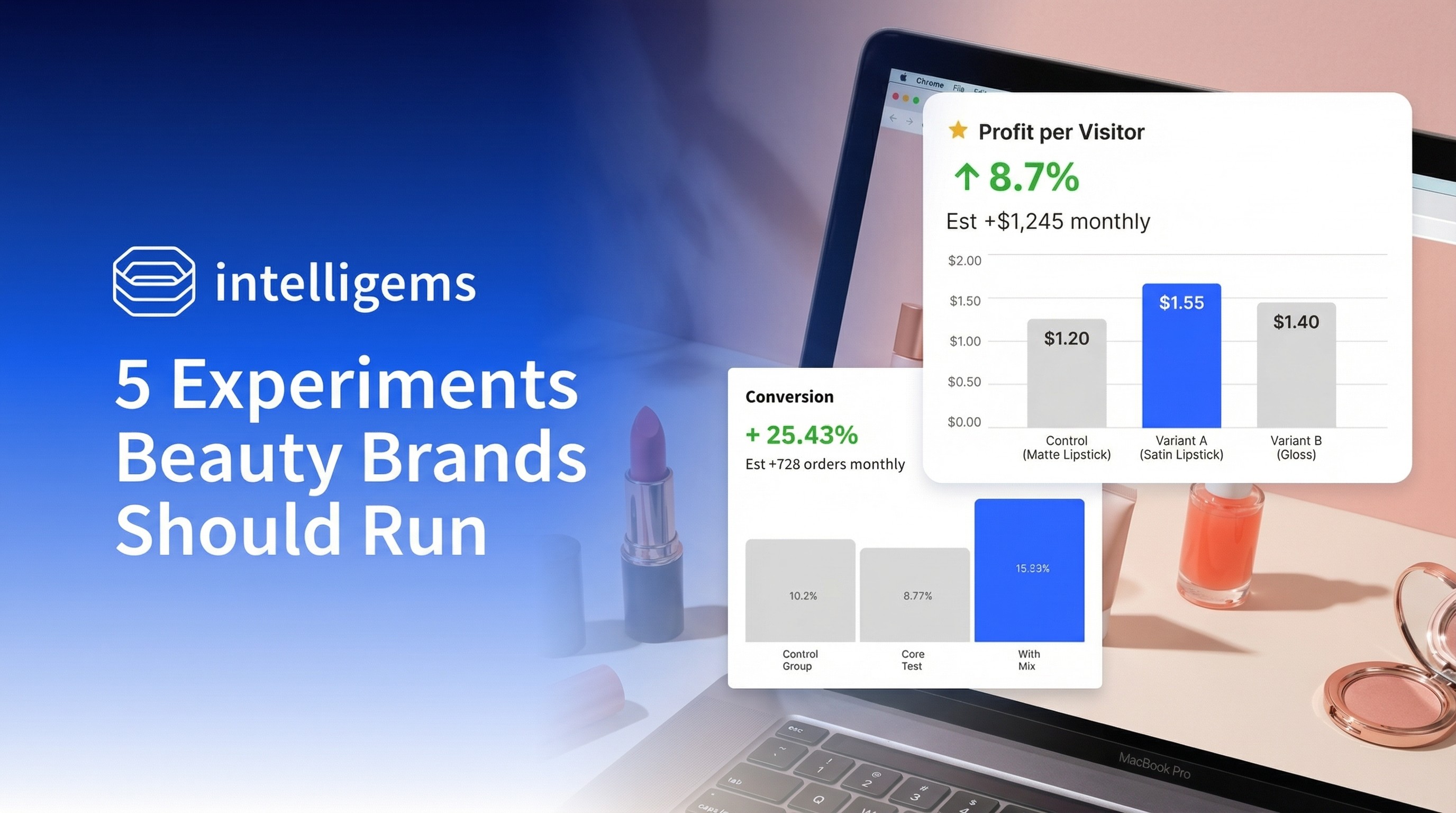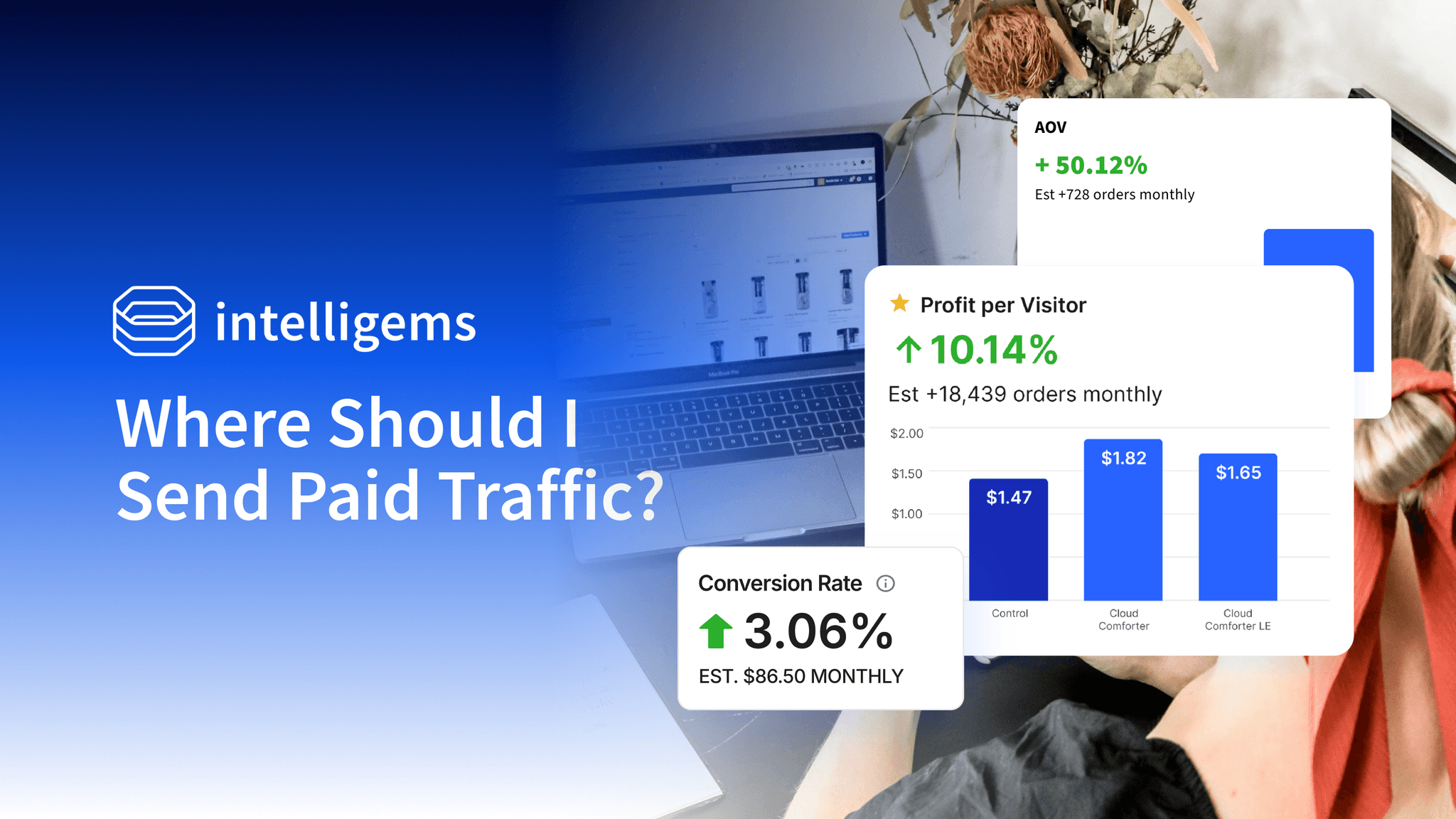Price Testing
Sep 29, 2025
How Do I Know If My Prices Are Right?
Most brands set prices using costs, competitors, and gut feeling. But there's a way to know for certain what customers will pay
Most brands try to triangulate pricing using three inputs: their costs, competitor prices, and perceived customer value.
Nailing the first two is easy. You know what your costs are, and can easily take a look at competitors. But how do you know what a customer would be willing to pay? You end up needing to estimate the third.
Let's explore how you can test your prices so that you don't need to guess; you can know.
How Do Most Brands Test Prices?
Historically testing prices was difficult, time consuming, and the tactics weren't the most reliable. Well, that's until Intelligems came along.
Here are a few ways price testing is done today.
While only one is "truly reliable," the others can be used to get a signal.
Before-and-after
This tactic has you choose a date to change your prices. You then change the price starting at that point and compare the results with one another.
As an example, an alpaca sweater brand raises it’s prices from $150 to $175. Sales stayed steady. Success?.
Not necessarily. That same week, the temperature dropped from 95°F to 30°F, their competitor raised prices too, an influencer featured alpaca wool, and a holiday sale started right after.
You're not controlling for external factors. Which one mattered? You can't be certain.
Daily rotation
In this scenario, you test by alternating different prices on different days. As an example, you sell on Mondays at $49, and Tuesdays at $59. Monday sells well, Tuesday doesn’t.
But consider what else might be happening: Monday was payday for many customers, Tuesday saw a competitor's flash sale, and returning customers see different prices each day. Are they buying because $49 is right, or because it feels like a discount? You've created unintentional anchoring.
Discount testing
A simple approach. You use discounts to simulate different prices. You price your products at $69, then test discounts: $10 off for some customers, $20 off for others.
Of course the $20 group bought more. But they weren't evaluating price. They were reacting to a discount and anchored to a different price. You're testing discount perception, not price sensitivity.
A/B testing
A/B testing is different. You don’t need to make any manual changes, you won’t fall victim to bias, and you don’t need to worry about seasonality. Shoppers are sorted into groups based on the targeting criteria you set.
It's the only method that eliminates variables and shows you how customers actually react to price.
Why A/B Testing Gives You Certainty
It solves every problem the other methods create
A/B testing shows different prices to different visitors at the exact same time. Same Monday morning, same weather, same everything except price.
This creates the ideal pricing experiment:
Real purchases: Customers vote with their wallets, not their words
No confusion: Each customer sees one consistent price
Clear results: Only price differs between groups
True knowledge: When conversion differs, price caused it
Benefits over traditional methods:
No time lag: Both prices tested simultaneously
No anchoring: Customers don't see price changes
Real behavior: Not survey responses or hypotheticals
Confidence levels: See how certain you can be
When you run an A/B test, you are no longer guessing or hoping. You know.
Hear how Jaxxon's Head of Revenue uses continuous price testing to own contribution margin by product and make data-driven pricing decisions that added seven figures to their bottom line. Michael discusses the testing framework and mindset shift needed to move from guessing to knowing.
What Price Should I Test First?
Start with straddle testing - modest changes up and down
Test prices on both sides of your current price. If you're selling at $150:
Test lower: $135-140 (e.g., 10% down)
Test higher: $165-170 (e.g., 10% up)
Keep control: $150 (current baseline)
These represent 5-10% price changes from your baseline - the sweet spot for initial price testing.
Why 5-10%? Big enough to see clear results quickly. Small enough to stay reasonable. You picked $150 for a reason - you're not jumping to $250 overnight.
Start with your best-seller for quick data. One caveat: respect your margin requirements. Your finance team likely has minimum margin thresholds you need to maintain - don't test below those boundaries unless it's a deliberate loss-leader strategy.
What The Metrics Reveal If You're Right?
Focus on profit per visitor to know the truth
What you measure is determined by your brands unique goals, but generally speaking we like to focus on four key metrics.
Conversion rate: How many visitors buy
Average order value: How much they spend
Revenue per visitor: Conversion × AOV
Profit per visitor: Revenue minus costs per visitor
Why profit per visitor matters most:
You might grow revenue while compressing margins so much that profit goes down. A 5% conversion drop with 15% higher prices often increases profit. Only profit per visitor tells you if you're actually winning.
Track daily and watch your confidence grow. Act when the data tells a clear story.

What's the Simplest Test I Can Run?
Follow these steps to find certainty in your pricing
Step 1: Pick Your Collection
Your best-selling collection (lots of data quickly)
Single collection (not whole catalog)
Decent margin across the collection
Step 2: Set Your Straddle Test
Control: Current price
Variant A: 5-10% lower
Variant B: 5-10% higher
Step 3: Run Until You're Confident
Check daily for anomalies
Don't change mid-test
Watch confidence levels grow
Act when you have enough certainty
Step 4: Act on What You Know Look at profit per visitor for each group. The winner might surprise you. Sometimes higher prices with lower conversion drive more profit.
Now you have certainty instead of doubt.
How Long Should I Run My Test?
Your data will tell you when it's ready
Two things affect timing: more traffic gives you faster results with more visitors, while bigger changes mean clearer patterns emerge sooner.
This is why we suggest 5-10% changes. They're big enough to see results quickly, small enough to stay reasonable.
Some brands see clear patterns in days. Others need weeks. As a general rule of thumb, run your test for at least two weeks to capture full weekly shopping patterns. Watch for your results to stabilize and tell a consistent story day after day.
Remember: pricing isn't permanent. You can change prices and change them back. You don't need perfect certainty to make a decision - just enough confidence to act.
Check daily to ensure things run smoothly. When the pattern becomes clear and consistent, you're ready to decide.
Common Mistakes That Keep You Uncertain
Avoid these testing pitfalls
Avoid these testing pitfalls:
Testing during sales: Promotional periods skew truth
Changing mid-test: Invalidates everything
Ignoring profit: Revenue alone misleads
Testing everything: Start with one collection
Trusting surveys: "Would you pay $80 for this?" "Sure!" But when they see the actual price: "Nah."
Remember: Don't trust what people say. Trust what they do. There's a big gap between "I'd pay $80" and actually pulling out the credit card.
Stop Guessing. Start Knowing.
Most brands are flying blind with pricing. They make changes based on gut feelings, then scramble to rationalize the results afterward.
They try to balance costs, competitors, and customer value, but lack certainty on what customers will actually pay. Three traditional testing methods can't isolate price impact. Weather changes. Competitors move. Seasons shift. You end up with data that looks meaningful but leaves you uncertain.
A/B testing changes everything. Same conditions, different prices, clear results.
Find certainty in your pricing:
Pick one product
Run a straddle test (5-10% up and down)
Measure profit per visitor
Know what works
Don't guess what to set your prices at. Know!
Ready to find certainty in what customers will pay? When you're ready to know for sure, let's get you testing beyond what's typical.
AB Testing
Expert Guide
Analytics









